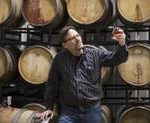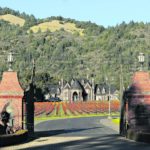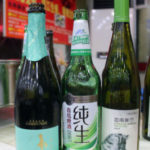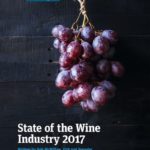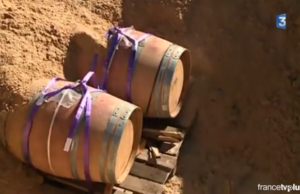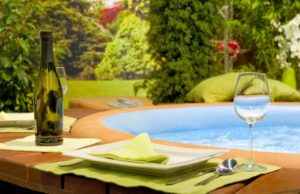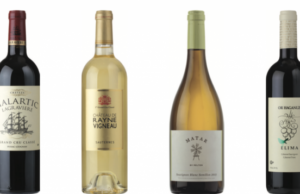Organic Wine, the future of wine, and why vintage 2017 is looking so good.
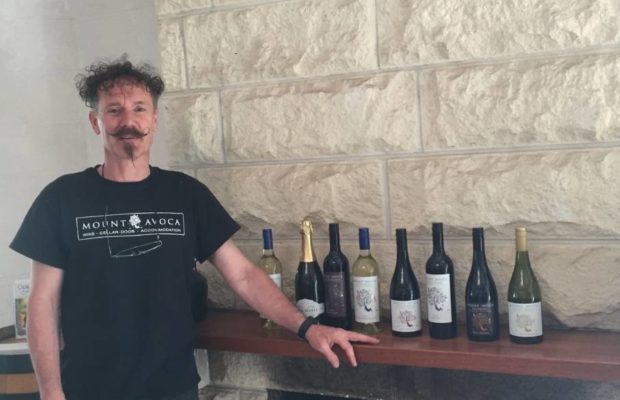
Click here to view original web page at www.thecourier.com.au
The Pyrenees has a special place among the winemaking regions of Australia. Having been one of the few areas in Australia to avoid the phylloxera plague of the late Nineteenth Century, it has an unbroken lineage to the original plantings in Victoria of the 1860s.
Famed for its eucalypt-tinged shiraz and busty cabernets for many years, in recent times its vignerons look to diversify the varieties they plant and the kinds of wine they make.
Mt Avoca’s Matthew Berry is the second generation of his family to make wine here. His father, an old-school stockbroker, began the vineyard in the 1970s as a hobby, one that eventually became a passion.
After a decade of drought and then remarkably unsettled seasons which followed – flooding, heatwaves and warm dry winters – this autumn’s harvest is exciting the region’s vignerons.
While the cautionary premise that nothing is brilliant until it’s bottled always applies, the tumult the wine industry has endured in recent years seems to be passing.
And the 2017 grape harvest is promising lush fruit and intense flavours. It could be a truly great year for wine.
Matthew Berry paused from his vintage preparations to speak with The Courier about the region, the changes in palate of wine drinkers over time, his decision to become an organic winegrower and the prospects of a great 2017 vintage.
When did you start in the winery?
My father started in 1970 and so I worked with him as a little kid growing up, catching tadpoles and getting gumboots stuck in the mud and that kind of thing. Then he sold it in 2001 to a group which bought four wineries.
And the guy behind that was not quite smart as he thought was, and in a very short space of time the bank stepped in. So in 2003 I bought it back from the bank that financed him.
What was your father’s background?
My father was a stockbroker. He enjoyed the old-school stockbroking, where you looked at companies, like mining companies, and you actually did research on what they had, and you invested on the basis of the reality and projected the profits and that kind of thing.
I think when things got a little bit more speculative and people were buying companies when the share price went down and selling off the assets and destroying them, he said “it’s not really what it’s all about.” So I guess he had old-school sort of values.
And he always liked the idea of doing something and getting his hands dirty, so it was eventually part-time stockbroking and more up here.
The Pyrenees is one of the earliest-established winegrowing areas. Did he did he come here with a focus on being in the Pyrenees or did he look elsewhere?
He actually did a lot of a lot of research. That was back in the days when we actually had a Department of Agriculture and a state viticulturalist, so you had someone who could you could talk to who had that knowledge.
They were actually looking originally more towards the north-east because my parents skied and thought they’d get something on the way to Falls Creek. So they were driving through Millewa and looking around Rutherglen and all those sorts of areas.
But having done the research – and I think it was back in the day when John Whiting was the state viticulturalist, and he did a lot of research – the Pyrenees was highlighted as ideal in terms of soil climate north of the Divide, much drier, very little disease pressure. Which actually flows really well into us being organic now and having no chemicals on the property.
And coincidentally, there were some French and Americans was looking around. So my father knew John Robb at Chateau Remy (now Blue Pyrenees) and this block of land came up and so they got that and it was about the time when David Hohnen started off at what’s now Taltarni.
I guess (we were) focusing on the flavours and trying to get the varietal characters into the wine, rather than just making some big, tannic, alcoholic monster.
So that was in the early 70s, a lot of a lot of growth there. Summerfield started off about the same time as well, around 1970. It was one of those periods when people were looking and. I guess it is no coincidence we went from one winery here in the 60s to eight or nine in five years.
The variety that, for better or for worse, the Pyrenees is known for is shiraz. But in fact people are branching out into all kinds of varieties now. Did your father and yourself start with that idea of shiraz?
Yeah, the first vines we planted were shiraz. And I guess shiraz and cabernet were the two major varieties in Australia at the time and interestingly the cabernet is probably the most consistent in terms of year-in, year-out. We won more gold medals with the cabernet. Possibly a little bit to do with the clone we had of the shiraz.
And I guess at that stage too, in the 70s and 80s, 90s we were making more of an elegant style which has become more popular now with more medium-to-heavy weight but not really big, ballsy, solid. I guess focusing on the flavours and trying to get the varietal characters into the wine, rather than just making some big, tannic, alcoholic monster.
But back in the days everyone wanted these really big gutsy wines, so we were a little bit of ahead of the curve.
I think the style we’re doing now is actually a continuation of what my father started; so now what we’re doing (people saying) “oh wow, it’s great, it’s elegant” – and we’ve seen, probably since 10 or 15 years ago, the show circuit’s moved away from rewarding just these monsters to actually looking at structure and flavours and balance.
So that’s something we always had.
The shiraz was was the largest planting, and then a bit of cabernet after that in ‘72.
And then we didn’t do much for a long time. In the 80s we planted sauvignon blanc, again which was fairly ahead of the curve and it was quite good – got a trophy with our first-ever sauvignon blanc, which was pretty rewarding for dad.
And then a couple of years after that we planted some acres of chardonnay and it really gave us that sort of well-rounded shiraz/cabernet/little bit of merlot/sauvignon blanc and chardonnay – they were the classic varieties of it that period.
Now we’ve got lagrein; we’ve got tempranillo; we make a nebbiolo from a vineyard over the hill; we have viognier. We also make a bit of pinot grigio from, again, a nearby vineyard; a sangiovese.
So all those things are really quite exciting. And what actually started me was Dr Richard Smart, a fairly well known viticulturalist; he did a lot of work on mapping different climates around the world, and he came up with a map of what he called ‘homoclimes’ which was climates that were quite similar.
And quite interestingly the weather data for this area was quite similar to Rioja.
But because the weather stations have really obscure names – I think one of them was Tanwood which was a town which existed 100 years ago, exists on a map but there are actually no houses there, or there might be one house, but the weather stations carry on with these names of yesteryear
So I looked at this map and this data and said, ‘wow, there’s two or three areas that are really close to us and they’re Pyrenees’, but it wasn’t so obvious because unless you knew the names you couldn’t join the dots.
Having seen that information we planted some tempranillo. It’s just fantastic; really great flavours and it’s just lovely. It has something which tastes different, it’s just a different flavour profile.
So having done that it was just a logical progression to play with more things, and the exciting thing is people love it. “Oh wow! It tastes so different!” Instead of being plum and pepper like a shiraz, you go, “Oh it’s got rosemary, it’s got basil, it’s got these other herbal flavours!”
It just becomes quite exciting to do that.
It is exciting to think of, when you look at the different climates around the world, to think ‘we could do this here’ – there are Spanish varieties, there are Greek varieties, there are southern French varieties. Do you think the palate of the wine drinker in Australia is getting more adventurous, more sophisticated? If we talk about the big shirazes of the 70s and 80s and the era of the long lunch. People quite memorably loved that: ‘Bang! let’s have something 14, 15 per cent.’ That has changed a lot, hasn’t it?
I guess the demographics change as well. So I know that the people that bought our wine back in my father’s day, you know, they’ve got full cellars, or they’re octogenarians, their drinking days are probably not quite as – voluminous – as they might have been.
Everyone drinks wine now. In the old days it was, you know, unusual and a certain age. Now you go out and you’ll see everyone over the age of 18, either gender, drinking all sorts of things. You’ll see a table of young ladies drinking bottles of cabernet and merlot.
It’s very difficult, I think, to make the generalisations that we could make years ago, because people like different things. And I think also, going hand-in-hand with that is this interest in food. So we’ve got this absolutely phenomenal interest in reality chefs and cooking programs, and there’s probably three or four television channels devoted entirely 24 hours a day to cooking.
For me, wine is the sixth food group, you know – it’s part of what you do when you eat; you have wine and it goes with the food and augments the meal
So if we’re eating more adventurously and trying different foods, wine’s part of that. I’m waiting for the wine channel to come on.
For me, wine is the sixth food group, you know – it’s part of what you do when you eat; you have wine and it goes with the food and augments the meal. It’s something which, if you only have one or two wine, it makes no sense when you’ve got 5000 kinds of food. And we’ve seen Greek, Italian people are really getting back to their roots and reintroducing… they’ve always had a wide range of cuisine.
I think the great things about Australia was that that multicultural aspect, that history of people having come from all over the world. So we’ve always had that, but I think now we’re getting a lot more detail in that people saying, “oh it’s not just Greek: this is from this village on this island and we do this,” and so it’s more specifics, it’s more more detail in its flavours.
So I think corresponding to that, people want to have this wine or that wine, and matching flavors is part of all that, that whole ability to take time to look at food and then expand on that with the wines. I think that’s opened doors to people trying a whole lot of wines and I’m sure a lot of them think of themselves as being adventurous: “I like this! I’ll drink it! End of story!”
Your (wines are) organic. Tell me the thinking behind that, because it’s quite a process to become certified. And it requires constant attention, doesn’t it?
Absolutely so.
I guess we’ve always had a very strong, what I call a ‘clean and green ethic’, which my father started. One the reasons for this location was that we had little disease pressure. Little disease pressure means less chemicals.
We also were involved in the 80s in projects with the Department of Agriculture in developing minimal chemical usage with weather stations and data loggers and things like that; so that was something which was fairly important for us in that it covers off two areas: using less chemicals which is good, and often you can be efficient and sustainable economically as well.
If you’re spending less money on things like chemicals, then you’re putting that money into the good stuff, so that was that was important.
It was all about quality: how we get those flavors to increase, to get that intensity, to get that real verve, that excitement into the bottle
And then in the mid 2000s I did a tasting down in Melbourne. It was a biodynamic tasting from winemakers all around the world.
I do a lot wine tastings and some are great, some are OK, some are not so good. This had a theme and I was really impressed that all of wines, even the wines that I was not that crash hot on – there was a quality aspect, a vivacity, a verve. It was really an aspect of life coming out; they were just full of energy, full of life.
That made me think, ‘ah this organic biodynamic thing might have something,’
The reason we went down that path wasn’t because we in particular wanted certification, and we did five or six years of organic viticulture without even opening that Pandora’s box of bureaucratic nightmare to become organic.
It was all about quality: how we get those flavors to increase, to get that intensity, to get that real verve, that excitement into the bottle; and having tried these, I thought ‘common theme’ – there’s something about that.
I’m a scientist. I look at things pretty much on the facts and it can be interesting – how do you measure these things?
Sometimes it’s hard to come up with the hard data, but when you try a whole lot of wines, and my palette says, ‘Yep, there’s something in these, I like them’ – that was enough to give me that that level of confidence across a wide spectrum of wines that there was a real difference and quality, not just in the winemaking but there was actually some hard data on ‘let’s go organic and we’ll make better wine.’
I think the first one I can recall trying, because it was organic, was a Kalleske from South Australia. And what you’re saying was immediately apparent; that it was a different wine from other wines. It had a singularity about it. Over the years I had several conversations with Alex Podolinsky. I was always fascinated by the people who came to him because there is that… you can be skeptical about BD500. But farmers who were well respected in the community would go to him when they took on his product, and would swear by it. And it’s quite fascinating because, yourself as a scientist, you know that it’s a difficult area to go into.
I think also one of the problems was some of the larger commercial wineries put out wines that were organic on the label – and they weren’t great wines.
The whole of the 2000s the wines were ‘organic’, they were ‘preservative free’ and the wines weren’t great; and even to this day some people shy away from putting ‘organic’ on the label. People go ‘yeah organic!’ and it’s not that good.
The people that we’ve seen in Victoria and South Australia that have been doing it for a long time, their reputation is based on the quality of the wine.
The really great wines that have that biodynamic or organic pedigree, they don’t talk about that. The brands are fantastic; they make great wine and part of that is, ‘we’re organic, were biodynamic and that’s part what of we do’; but if you’re only hanging your hat on one – ‘we’ve got this organic sticker and label’ – that’s not really, I think, what people want.
The people that we’ve seen in Victoria and South Australia that have been doing it for a long time, their reputation is based on the quality of the wine. Again, for us, it was just about, ‘let’s get the grapes absolutely to express their natural flavors and intensity as best we can,’ and then we take that through.
So it took us quite a long time, and in 2016 we got our first batch of fully organic wines, which again probably was to do with certification – a lot of the wines in ‘14 or ‘15 were made from organic grapes but we didn’t tick all the boxes in terms of going through the paperwork.
So it’s interesting.We’ve got our first lot of wines coming out which will be fully certified from earth right through to the to the glass.
What varieties are those?
An organic sauvignon blanc, an organic chardonnay and an organic lagrein; and then when more of the reds come out in the next year or so, those ‘16s will also be organic.
Let’s talk a bit about this year’s vintage, because it’s been the driest March in about 10 years. I was talking to a staff member inside earlier and he said this is a very typical March of the 1990s. Of course the climate has shifted. But it’s looking like being a good vintage this year?
Absolutely. In the 80s and 90s we’d start vintage around mid-March; 18th March was a pretty typical date to start.
And then in most of the 2000s it sort of ‘moved forward, moved forward’ early March, late February, even to mid-to-early February. So, depending on the season, about a four to five weeks earlier.
So this is really a throwback to the old days: warm but dry in March, and I guess that cool summer – we had probably more warm days in March than we had in January or February, which is kind of crazy. But the quality is looking fantastic, the vineyard’s never looked better.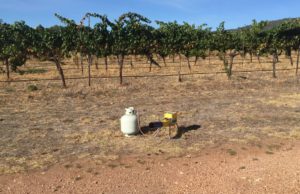
We had a lot of rain last winter and spring and this is the first time in in decades our dam has been full, and it’s almost full now at the end of summer, which is really quite quite amazing.
It’s lovely to see the growth. Obviously the composting organic is part of it, but water is the big thing.
Having seen this season, it just makes you realise that it’s the difference. More water, more growth. For us we’re such low vigour anyway. You know we can have the perfect season and we would still struggle to get more than two and a half tonnes to the acre, which is pretty low.
However just the plushness of the leaves, the better colour, and all of that goes through the vine health, it translates into good grapes, the skins are thicker. We’re going to get more tannin, more flavor. There’s just more to get into the juice, so that that will translate into more flavours and more weight and more texture and all those things that we really want in our wine.
Is it’s still exciting to be a winemaker? Do you get up every morning and think, ‘this is going to be something interesting, something new today’?
Always something new, always exciting.
I think anyone who runs small business would be aware that there’s a fairly high level of stress.
The market’s certainly turning around. We’ve had a pretty tough 15 years since probably the early 2000s, 2002. The wine glut really hit the market and that’s just dissipating now. China is picking up more of the slack, so a lot of the wine that used to go to the UK is now going into China.
But the good thing is the value of wine is going up; grape prices are going up, so I’d like to think in a few years we’re back in a more sustainable model. We had a lot of people, a lot of vineyards disappear. If the price of grapes is less than the cost of growing them it obviously doesn’t work.
But we probably needed a bit of a clean out. I think we’re at the point now where we’re getting back into balance. If you have supply and demand balanced, we’re in a much better place.
Just finally with the organic and the Chinese: the Chinese, a little bit stereotypically, but they are certainly focussed on the ‘top end’ wines. Do you think that they will embrace the idea of organic wines? I mean, as we said before, it’s ultimately about the quality of the wine, but it’s something that is a marketable idea?
There’s already interest. People want the new organic wine. I think as the market develops and it becomes more sophisticated that will increase. Japan has a more sophisticated market and in Japan the demand for organic is much stronger across all products but also wine. So I’d like to look at it a bit more this year and see if I can do something there.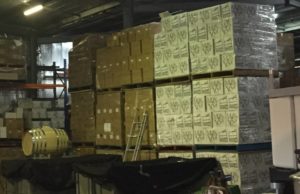
But we do already some quite good sales into into China, and as always, it’s a question of the price and the quality.
Everybody wants to buy a Rolls Royce but they are wanting to pay Hyundai prices. Bridging that gap and explaining the differences is is a challenge, I think in wine particularly. You can have two bottles. They look almost identical. One’s $4 a bottle, one’s $104 a bottle. Externally they look the same.
I guess the demographics change as well. So I know that the people that bought our wine back in my father’s day, you know, they’ve got full cellars, or they’re octogenarians, their drinking days are probably not quite as – voluminous – as they might have been.
The other product is ok, but it’s more of a production line product.
So getting that message across, like any product, it’s important. But wine faces some challenges, in that if you’re not a wine person it can be hard to pick the difference and externally – you know, you get a cheap bottle with great packaging, an expensive one with ho-hum packaging, (they say) well ‘why would I pay $100 when I can get it for $4?’
And that’s a little bit of the dialogue that is going on, and that’s part of the story that we have to tell.


